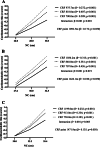Neck circumference and cardiometabolic risk in children and adolescents: the moderator role of cardiorespiratory fitness
- PMID: 34001053
- PMCID: PMC8127299
- DOI: 10.1186/s12887-021-02696-y
Neck circumference and cardiometabolic risk in children and adolescents: the moderator role of cardiorespiratory fitness
Abstract
Background: The increased incidence of cardiometabolic risk factors has become a public health issue, especially in childhood and adolescence. Thus, early identification is essential to avoid or reduce future complications in adulthood. In this sense, the present study aimed to verify the influence of cardiorespiratory fitness (CRF) as a moderator in the association between neck circumference (NC) and cardiometabolic risk in children and adolescents.
Methods: Cross-sectional study that included 2418 randomly selected children and adolescents (52.5% girls), aged 6 to 17 years old. Anthropometric measurements, such as NC and body mass index (BMI), and CRF was measured by the six-minute running/walking test, as well as cardiometabolic risk (systolic blood pressure, glucose, HDL-C, and triglycerides), were assessed.
Results: For all age groups, NC showed a negative relationship with CRF. A significant interaction term was found for CRF x NC with cardiometabolic risk for children (6 to 9 years old), early adolescents (10 to 12 years old), and middle adolescents (13 to 17 years old). It was found that children who accomplished more than 1092.49 m in CRF test were protected against cardiometabolic risk when considering NC. In adolescents, protection against cardiometabolic risk was found when the CRF test was completed above 1424.14 m and 1471.87 m (early and middle stage, respectively).
Conclusions: CRF is inversely associated with NC and acts as a moderator in the relationship between NC and cardiometabolic risk in children and adolescents. Therefore, this detrimental health impact linked to fatness might be attenuated by improving CRF levels.
Keywords: Anthropometry; Metabolic syndrome; Obesity; Pediatrics; Physical fitness.
Conflict of interest statement
The authors declare that the research was conducted in the absence of any commercial or financial relationships that could be construed as a potential conflict of interest.
Figures
Similar articles
-
What is the role of cardiorespiratory fitness and sedentary behavior in relationship between the genetic predisposition to obesity and cardiometabolic risk score?BMC Cardiovasc Disord. 2022 Mar 9;22(1):92. doi: 10.1186/s12872-022-02537-5. BMC Cardiovasc Disord. 2022. PMID: 35264112 Free PMC article.
-
Association between cardiorespiratory fitness and cardiometabolic risk factors in Brazilian children and adolescents: the mediating role of obesity parameters.Paediatr Int Child Health. 2021 May;41(2):93-102. doi: 10.1080/20469047.2020.1838758. Epub 2020 Oct 28. Paediatr Int Child Health. 2021. PMID: 33112727
-
Independent and Interactive Associations of Fitness and Fatness With Changes in Cardiometabolic Risk in Children: A Longitudinal Analysis.Front Endocrinol (Lausanne). 2020 Jun 12;11:342. doi: 10.3389/fendo.2020.00342. eCollection 2020. Front Endocrinol (Lausanne). 2020. PMID: 32595599 Free PMC article. Clinical Trial.
-
Cardiorespiratory Fitness in Childhood and Adolescence Affects Future Cardiovascular Risk Factors: A Systematic Review of Longitudinal Studies.Sports Med. 2018 Nov;48(11):2577-2605. doi: 10.1007/s40279-018-0974-5. Sports Med. 2018. PMID: 30144022 Free PMC article.
-
Association of Cardiorespiratory Fitness Levels During Youth With Health Risk Later in Life: A Systematic Review and Meta-analysis.JAMA Pediatr. 2020 Oct 1;174(10):952-960. doi: 10.1001/jamapediatrics.2020.2400. JAMA Pediatr. 2020. PMID: 32870243 Free PMC article.
Cited by
-
Mediation of obesity-related variables in the association between physical fitness and cardiometabolic risk in children and adolescents: a systematic review and meta-analysis.BMJ Open Sport Exerc Med. 2025 Apr 3;11(2):e002366. doi: 10.1136/bmjsem-2024-002366. eCollection 2025. BMJ Open Sport Exerc Med. 2025. PMID: 40191840 Free PMC article.
-
[Correlation of neck circumference with body mass index in preschool children].Zhongguo Dang Dai Er Ke Za Zhi. 2022 Sept 15;24(9):1042-1046. doi: 10.7499/j.issn.1008-8830.2203072. Zhongguo Dang Dai Er Ke Za Zhi. 2022. PMID: 36111724 Free PMC article. Chinese.
-
The inverse relationship between fatness and bone mineral content is mediated by the adolescent appendicular skeletal muscle mass index: The Cogni-Action Project.Front Nutr. 2022 Nov 15;9:1040116. doi: 10.3389/fnut.2022.1040116. eCollection 2022. Front Nutr. 2022. PMID: 36458170 Free PMC article.
References
-
- Gaya AR, Dias AF, Lemes VB, Gonçalves JC, Marques PA, Guedes G, et al. Aggregation of risk indicators to cardiometabolic and musculoskeletal health in Brazilian adolescents in the periods 2008/09 and 2013/14. J Pediatr. 2018;94, 177:–83. - PubMed
Publication types
MeSH terms
LinkOut - more resources
Full Text Sources
Other Literature Sources


